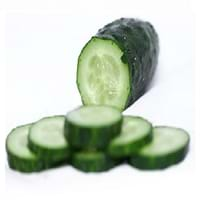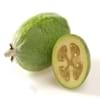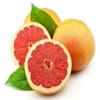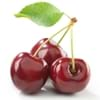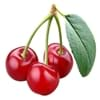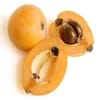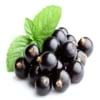feijoa lan timun
Wuku
Kesehatan keuntungan
anti depressant, Nyegah kanker, Nyuda tension gemeter, Perawatan saka penyakit Alzheimer, Perawatan saka penyakit Lung
perawatan atritis, Nyegah kanker, perawatan eczema, Mundhak tingkat metabolis, perawatan watu ginjel, ngalangi constipation, Mbusak beracun logam, Perawatan saka penyakit Alzheimer
Wuku Umum
sepindah pencernaan, Mbantu ing bobot mundhut, Mbenakake circulation getih, strengthens balung, Perawatan saka kadhemen umum
anti antioksidan, anti-natoni, Kontrol meksa getih, sepindah pencernaan, strengthens balung, Perawatan saka mata perih
Wuku kulit
Brightens lan madhangi corek, rejuvenation kulit
Yesus sunburn, kulit hidrasi, rejuvenation kulit, revitalization kulit, Perawatan saka panggonan peteng, Perawatan saka penyakit kulit
Wuku Rambut
Dipun promosiaken maneh lan sehat rambute, nglindhungi rambute
Dipun promosiaken maneh lan sehat rambute, nglindhungi rambute, Ngatur rambute wutah, mengilap rambute
alergi
Gejala alergi
NA
AMBEGAN kangelan, Nyuda ing meksa getih, diare, gatel, akeh Red, irung runny, wahing, mutahke, mata mbanyu
sisih efek
reaksi alergi
jantung ditekan, gangguan, dadi gedhe, Dadi gedhe sak tutuk, gedhe tenggorokan, ibu gedhe, getih prau saring
Recommeded kanggo
Women ngandhut
Ya
Ya
Women lactating
Ya
ora Sumadhiya
Wektu paling apik kanggo mangan
Minangka cemilan ing afternoon pungkasan, Ora nganggo ing wayah wengi lan sadurunge amben, Mangan sing gedhe-gedhe seger, supaya nyawiji karo sembarang panganan, ora mangan sawise meal., wektu esuk (sadurunge nedha awan)
Bebarengan karo meal, Minangka cemilan ing afternoon pungkasan, Mangan sing gedhe-gedhe seger, supaya nyawiji karo sembarang panganan, ora mangan sawise meal., Strictly supaya weteng kosong
Nutrition
Bantu Size
100 g
100 g
karbohidrat
12.92 g
38
3.63 g
99+
serat
6.40 g
7
0.50 g
40
Sugar
8.20 g
33
1.67 g
99+
protein
0.98 g
27
0.65 g
99+
Protein kanggo milai rasio
0.05
22
0.19
8
vitamins
Vitamin A (retinol)
ora Sumadhiya
5.00 MCG
30
Vitamin B1 (thiamin)
0.01 mg
99+
0.03 mg
34
Vitamin B2 (riboflavin)
0.02 mg
40
0.03 mg
27
Vitamin B3 (niacin)
0.30 mg
99+
0.10 mg
99+
Vitamin B5 (pantothenic asam)
0.23 mg
24
0.26 mg
20
Vitamin B6 (Pyridoxin)
0.07 mg
25
0.04 mg
99+
Vitamin B9 (folic asam)
23.00 MCG
11
7.00 MCG
28
Vitamin C (Ascorbic asam)
32.90 mg
26
2.80 mg
99+
Vitamin E (Tocopherole)
0.16 mg
32
0.03 mg
40
Vitamin K (Phyllochinone)
3.50 MCG
19
16.40 MCG
5
Lycopene
5.00 MCG
7
0.00 MCG
9
lutein + zeaxanthin
27.00 MCG
26
23.00 MCG
28
kolin
ora Sumadhiya
6.00 mg
20
lemak
0.60 g
14
0.11 g
99+
Minerals
kalium
172.00 mg
99+
147.00 mg
99+
Iron
0.14 mg
99+
0.28 mg
37
sodium
3.00 mg
17
2.00 mg
18
calcium
17.00 mg
24
16.00 mg
25
Magnesium
9.00 mg
26
13.00 mg
22
seng
0.06 mg
27
0.20 mg
14
fosfor
19.00 mg
26
24.00 mg
21
Manganese
0.08 mg
34
0.08 mg
35
tembaga
0.04 mg
99+
0.04 mg
99+
selenium
ora Sumadhiya
0.30 MCG
14
Asam lemak
3s Omega
58.00 mg
13
5.00 mg
33
6s Omega
214.00 mg
9
28.00 mg
99+
Sterol
Phytosterol
ora Sumadhiya
7.30 mg
11
Kadar banyu
83.28 g
99+
95.23 g
1
Ash
0.38 g
34
0.38 g
34
Kalori
Bantu Size
100 g
100 g
Kalori ing woh Fresh karo Peel
ora Sumadhiya
15.00 kcal
99+
Kalori ing Fresh woh tanpa Peel
55.00 kcal
12
12.00 kcal
25
Kalori ing Frozen Formulir
ora Sumadhiya
ora Sumadhiya
Kalori ing Formulir Dried
747.00 kcal
1
ora Sumadhiya
Kalori ing Formulir Canned
ora Sumadhiya
ora Sumadhiya
Kalori ing Foods
Kalori ing Juice
25.00 kcal
40
ora Sumadhiya
Kalori ing Jam
220.00 kcal
24
ora Sumadhiya
Kalori ing Pie
300.00 kcal
18
ora Sumadhiya
Ciri
Koleksi
woh wit
sayur-sayuran woh, melon
Usum
Autumn, Winter
spring, Summer
varieties
Anatoki, Gemini, Kaiteri, Kakariki, Pounamu, Unik, Apollo, Den Choice, Kakapo, Mammoth, Opal Star, Triumph lan Wiki Tu
Armenian, Inggris, Garden, Kirby, Lemon lan Persia
seedless Macem-macem
Ora
Ya
warna
Green
Ijo peteng, Green
nang werna
putih
putih
wangun
oval
bentuke silinder
Tekstur
succulent
crunchy
rasa
manis
jus, mbanyu
asal
Argentina, Brazil, Paraguay, Uruguay
India
mundak akeh ing
ora Sumadhiya
vines
budidoyo
Koleksi lemah
Clay loam, loam gravely, Sandy
loam
PH lemah
6-6.5
6-6.8
Kahanan iklim
Cold, anget
anget
Facts
facts about
Character length exceed error
Character length exceed error
Ing Minuman Beralkohol
Wine
Ya
ora Sumadhiya
Beer
Ya
Ya
roh
Ya
Ya
koktail
Ya
Ya
Produksi
Top Producer
New Zealand
China
Negara sing
Australia, Azerbaijan, India, Japan, Amerika Serikat saka Amerika
Mesir, Indonesia, Iran, Japan, Rusia, Spanyol, Turkey, Ukraina, Amerika Serikat saka Amerika
Top Importir
China
France
Top Used
New Zealand
Spanyol
Jeneng èlmiah
Jeneng botani
Acca sellowiana
Cucumis sativus
sinonim
Feijoa sellowiana utawa Orthostemon sellowianus
Klasifikasi
domain
Eukarya
Eukarya
Inggris
Plantae
Plantae
Subkingdom
Tracheobionta
Tracheobionta
Division
Magnoliophyta
Magnoliophyta
kelas
Magnoliopsida
Magnoliopsida
subkelas
Rosidae
Dillenhidae
supaya
Myrtales
Cucurbitales
Family
Myrtaceae
Cucurbitaceae
genus
Acca
Cucumis
spesies
A. sellowiana
C. sativus
Generic Group
Myrtle
ora Sumadhiya

